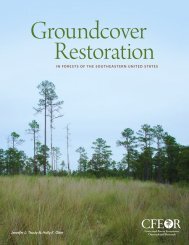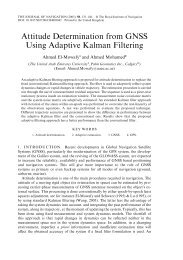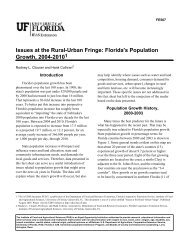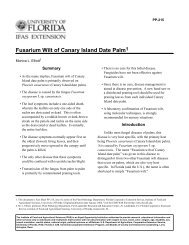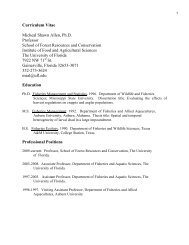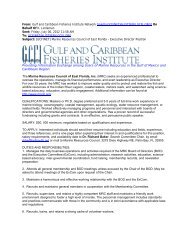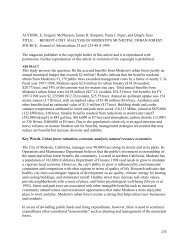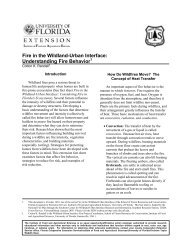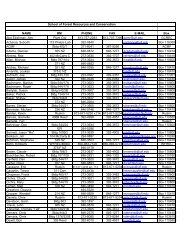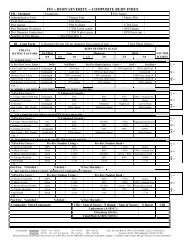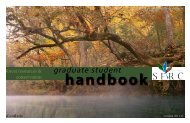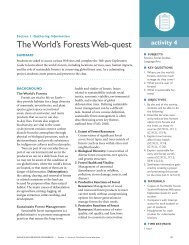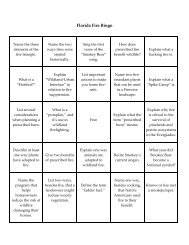Chapter 4: Plant Succession and Disturbances in the Urban Forest ...
Chapter 4: Plant Succession and Disturbances in the Urban Forest ...
Chapter 4: Plant Succession and Disturbances in the Urban Forest ...
You also want an ePaper? Increase the reach of your titles
YUMPU automatically turns print PDFs into web optimized ePapers that Google loves.
<strong>Chapter</strong> 4: <strong>Plant</strong> <strong>Succession</strong> <strong>and</strong> <strong>Disturbances</strong> <strong>in</strong> <strong>the</strong> <strong>Urban</strong> <strong>Forest</strong> Ecosystem 12<br />
Figure 14. American kestrels are widely distributed <strong>in</strong><br />
North America. They feed on <strong>in</strong>sects <strong>and</strong> small mammals,<br />
which are present <strong>in</strong> early stages of succession (grasses<br />
<strong>and</strong> forbs). However, <strong>the</strong> American kestrel also requires<br />
<strong>in</strong>termediate <strong>and</strong> late stages of succession, such as mixed<br />
woodl<strong>and</strong>s (shrubs <strong>and</strong> trees) for nest<strong>in</strong>g. Photo by David<br />
Sarkosi<br />
scrub vegetation has a profound effect on wildlife<br />
habitat availability <strong>in</strong> Florida (Figure 15).<br />
Figure 15.2 Photo by Anne Birch<br />
Figure 15.3 Photo by Paul Schmalzer<br />
Figure 15. The Florida scrub jay (15.1) is endemic to <strong>the</strong><br />
scrub ecosystem <strong>in</strong> <strong>the</strong> sou<strong>the</strong>astern U.S. It requires a low<br />
shrub layer, bare ground <strong>and</strong> a few scattered trees (15.2)<br />
avoid<strong>in</strong>g canopied areas. The scrub ecosystem is<br />
ma<strong>in</strong>ta<strong>in</strong>ed by periodic fires (15.3).<br />
<strong>Succession</strong> <strong>in</strong> More Detail<br />
Figure 15.1 Photo by Wayne Peterson<br />
The Florida scrub jay (Aphelocoma coerulescens<br />
coerulescens) (15.1), an endemic species <strong>in</strong> Central<br />
Florida, is restricted to <strong>the</strong> p<strong>in</strong>e/oak scrub<br />
ecosystems (15.2). This bird requires a low shrub<br />
layer, bare ground <strong>and</strong> a few scattered trees, avoid<strong>in</strong>g<br />
heavily canopied areas. The scrub ecosystem is<br />
ma<strong>in</strong>ta<strong>in</strong>ed by periodic fires (15.3). In this case, if<br />
fire is excluded for long periods of time, a s<strong>and</strong> p<strong>in</strong>e<br />
canopy develops <strong>and</strong> scrub jays ab<strong>and</strong>on <strong>the</strong> site<br />
(Woolfenden <strong>and</strong> Fitzpatrick 1984) (15.4).<br />
Follow<strong>in</strong>g a severe disturbance, sites are <strong>in</strong>itially<br />
dom<strong>in</strong>ated by early successional plants, called<br />
pioneer species. Pioneers are usually prolific seeders<br />
(or sprouters), fast-grow<strong>in</strong>g <strong>and</strong> short-lived species,<br />
<strong>and</strong> generally <strong>in</strong>tolerant of shade.<br />
Pioneer species are <strong>the</strong>n followed by shrubs <strong>and</strong><br />
early successional trees which, <strong>in</strong> turn, are eventually<br />
replaced by late-successional species. Later<br />
successional species are generally shade tolerant <strong>and</strong><br />
may grow much more slowly. Their seedl<strong>in</strong>gs will<br />
survive <strong>and</strong> grow beneath an established canopy, <strong>and</strong><br />
eventually <strong>the</strong>y will overtop <strong>the</strong> shrubs <strong>and</strong> replace



